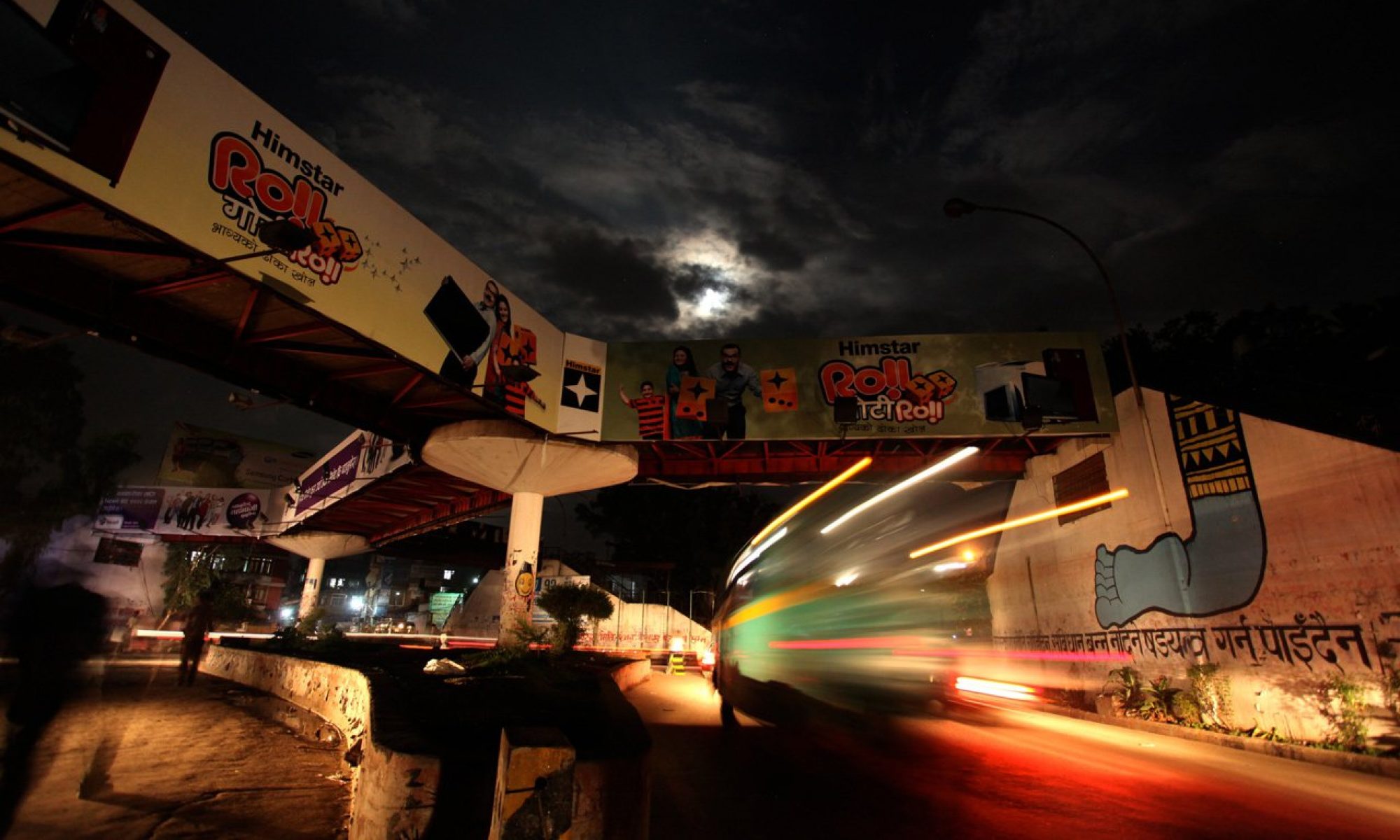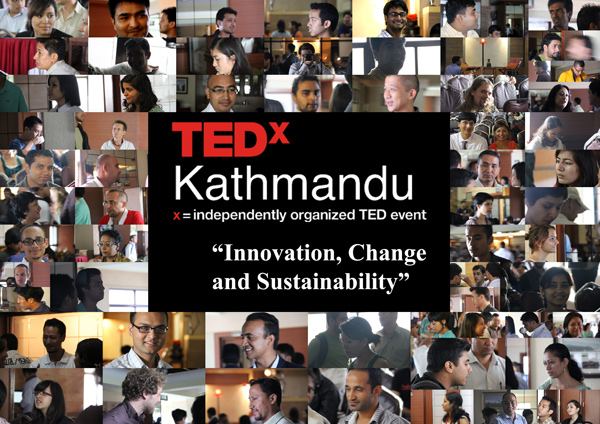On the 30th July, nine Nepalis with an ‘idea worth spreading’ became the first group of speakers in the inaugural TEDxKathmandu conference. As an independently organised TED Talk, TEDxKathmandu placed Nepal among a host of nations bringing a global discourse on Technology, Entertainment and Design (TED) to the local fore. Originating in the US in the 1984, TED talks create a secure space for new, inspirational or innovative ideas to be shared. The collective ‘lessons to be leant’ often transcend time and place. Based on universal themes, talks may be persuasive or courageous, fascinating or informative, beautiful or funny. A good presenter will challenge you to think beyond the norm, thus stimulating debate, provoking ideas and facilitating a new conversation.
The range of speakers at TEDxKathmandu reflects the diversity of social, political and activist cultures that are pertinent in Nepal today. Speakers included social activists Haushala Thapa and Anil Chitrakar; Mark Zimmerman, a doctor and Executive Director of the Nick Simons Institute; Sunil Babu Pant, Nepal’s first openly gay member of parliament; and Kedar Sharma, a writer, journalist and documentary film maker, to name a few.
Responding to the theme ‘Innovation, Change and Sustainability,’ speakers were allocated eighteen minutes to present their idea in the most captivating way. The theme, explains co- event organiser, Nimesh Ghimire, aimed to challenge the dominant national discourse of politics by providing a space for innovators, entrepreneurs and ‘those who think outside the box’. He elaborates that ‘particularly in developing countries like Nepal, when tackling various social and economic problems, we believe that delivery is more effective and efficient when we find ‘new ways’ of doing things’.
TEDxKathmandu can itself be considered one of these ‘new ways’ of doing things. Twenty year old Nimesh, along with his nineteen year old colleague, Shirish Pokharel truly embody the message they are trying to spread; that young people can and will make a difference. Through TEDxKathmandu they explain how ‘we wanted to create a platform whereby the 100 attendees – who themselves have a strong track record of innovation and connection to their communities – could get the inspiration and motivation to continue their works and take it to new next level’. The pair’s long term outlook is that TEDxKathmandu, as a yearly event, ‘will serve as a hub for someone seeking the inspiration, motivation and confidence to explore ‘new ways of doing things’ in society’. Indeed, with plans already in motion for 2012, TEDxKathmandu is sure to carve its niche as an important site of dialogue and exchange in the years to come.
Memorable moments from TEDxKathmandu 2011
Ani Choying Drolma
Change
It is always something special to listen to Ani Choying Drolma perform. Singing from her soul, each performance encapsulates the depth and breadth of Ani’s experiences growing up as a girl in a distinctly patriarchal household and society, and later her encounters with womanhood as a Buddhist nun. Reflecting heavily on her past, Ani addressed the TEDx audience on the importance of transforming negative experiences into opportunities for empowerment.
Revealing that her own childhood was met with instances of domestic violence which she ‘always felt just wasn’t right,’ Ani developed the courage to say no and resit the strict social hierarchy she was expected to conform. Embracing nunhood as a form of salvation from married life, Ani found the nunnery to be like a paradise when she entered. It is here that she met her guru and the ‘best man in the world’ who helped her transform anger and hatred into understanding and giving.
Change starts within. It starts with a change in attitude and a change in how we perceive the world. Delving further into mechanics of change and personal growth, Ani reiterated that spirituality does not necessarily mean giving to a temple or charity. True spirituality is ‘cultivating more and more the goodness we have in ourselves.’ It is about cultivating a thought process and praying for the wellness of people. ‘It is those things that make me happy,’ she concludes.
Salil Subedi
Performance, activism and transformation
 Performance actor, Salil Subedi, or Salil Kanikar as he is also known, energetically closed the conference with a captivating narrative of his experience as Nepal’s first didgeridoo player. Self taught fourteen years ago, Salil found succour in this fascinating new instrument, one which was pivotal to his personal quest to regain some control over his life. Today his didgeridoo, Rainbow Snake, is Salil’s main means of expression during his work with underprivileged children across rural Nepal. Bringing his performance to the hills and Terai, Salil says ‘you don’t need to explain anything, just go out and do it. They too will have something to teach.’
Performance actor, Salil Subedi, or Salil Kanikar as he is also known, energetically closed the conference with a captivating narrative of his experience as Nepal’s first didgeridoo player. Self taught fourteen years ago, Salil found succour in this fascinating new instrument, one which was pivotal to his personal quest to regain some control over his life. Today his didgeridoo, Rainbow Snake, is Salil’s main means of expression during his work with underprivileged children across rural Nepal. Bringing his performance to the hills and Terai, Salil says ‘you don’t need to explain anything, just go out and do it. They too will have something to teach.’
In keeping with the didgeridoo’s Aboriginal Australian heritage, Salil uses the instrument for storytelling. Combining music with activism, dance and performance, Salil communicates and presents social issues as an art form. It can also be a form of therapy. He explained the magic in how a ‘single hollow tube can bring so much joy and meaning to people’¦the simple tube can bring a lot of youth together.’ The environment and animal rights are also issues close to his heart. Asking ‘who speaks for the wildlife?’ Salil imparts that we need to take care of the earth’s rich biodiversity because ‘it took care of us for billions of years.’
His parting words and aptly those of the conference, succinctly reaffirmed the aspiration of TEDxKathmandu to create a new conversation on innovation, change and sustainability. ‘If you reach fixity of thought,’ he probed, ‘it becomes a commodity. We need to live in the twilight zone. All of us are artists- go find your twilight.’
Nayantara Gurung Kakshapati
Interpreting history through photographs
‘History is never only history of, it is always history for.’ – Levi Strauss
 History and the interpretation of history are powerful tools. With historical recounts often shaping a nations psyche, the construction of past events often serves a contemporary agenda. Why do leaders evoke images of the nations past hero, and neglect to recall the struggles of the everyday? Why is history written from the perspective of the victors, while the rest of society- the women, the children and the minorities- are systematically excluded? Is it truly possible to suspend one’s preconceived notion of a historical narrative and view the world from a decentred position?
History and the interpretation of history are powerful tools. With historical recounts often shaping a nations psyche, the construction of past events often serves a contemporary agenda. Why do leaders evoke images of the nations past hero, and neglect to recall the struggles of the everyday? Why is history written from the perspective of the victors, while the rest of society- the women, the children and the minorities- are systematically excluded? Is it truly possible to suspend one’s preconceived notion of a historical narrative and view the world from a decentred position?
Yes. According to Nayantara, this is all possible when we believe that history begins at home. Over the centuries Nepali history has been a history of kingdoms, where Gorkha or Rana rule dominates the discourse. But the nation’s collective history must stretch far beyond that. As Nayantara proposes, memories are your history. They become the nation’s history when told together; A collective memory. The Nepal Memory Project, an event run by Photo Circle, is Nayantara’s attempt to contextualise, redefine and reshape Nepal’s history from the perspective of the people. The stories from each photograph become a part of a larger narrative that builds a socio-cultural pictorial of old Nepal.
Postmodernists are relativists. They argue that there is no such thing as an objective truth as historical practice his inherently shaped by context and bias. A distorted historical construct is thus meaningless when truth and accuracy remain in the hands of the dominant culture. The Nepali Memory Project endeavours to construct a more accurate and enduring history of real Nepal; one that is removed from the dominant culture and is shaped by the people. After all, ‘we are all historians’.
See https://www.photocircle.com.np/ for more information about the Nepali Memory Project and also their upcoming event Rewind, Recapture and Rewrite.
Prabhas Pokharel
Innovation- Half Inside Half Outside
 I was thoroughly impressed when Prabhas Pokharel, an activist for social development, opened his presentation with this not so threatening but otherwise exciting proposition: innovation and change come from being both within and outside of a system. The system of course refers to that intangible but all powerful entity that you know needs to be modified but you just don’t know where or how to start. So you don’t. Or you endeavour to challenge the system only to find that it is too big and too established to even be slightly rocked.
I was thoroughly impressed when Prabhas Pokharel, an activist for social development, opened his presentation with this not so threatening but otherwise exciting proposition: innovation and change come from being both within and outside of a system. The system of course refers to that intangible but all powerful entity that you know needs to be modified but you just don’t know where or how to start. So you don’t. Or you endeavour to challenge the system only to find that it is too big and too established to even be slightly rocked.
So the solution, Prabhas probes, is to play their game. You become a part of the system. In this way one will have the contextual knowledge necessary to identify sites of change, while simultaneously having the fresh and innovative perspective of an outsider. The leverage, thus, from those inside and outside is that they have the potential to bring about change within a constrained system. This potential lies in their ability to talk in an open and systemic manner and to decentre themselves from a perceived reality to readily embrace the different actually they are confronted with.
When applied to a Nepali context, there is great potential in reaching across borders to stimulate discussion and source innovative ideas from across the globe. Recognising this potential, Prabhas helps to lead ‘Nepal ko Yuva’ an organising bridging Nepali youth at home and abroad. Pariwartan (change) is one of their most recent projects that seeks to ‘promote the spirit of social and political entrepreneurship within youth’.
Ending just as he begun with something to get you thinking, Prabhas concluded that if the sun and the moon, which rarely see each other, can co-exist on the Nepali flag, then Nepalis should be able to build bridges across boundaries to find innovative solutions to contemporary problems. By being half inside and half outside of a system, people will have the knowledge and competency to initiate change.


